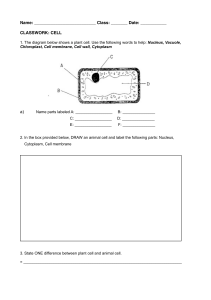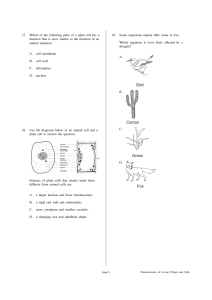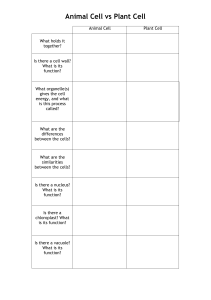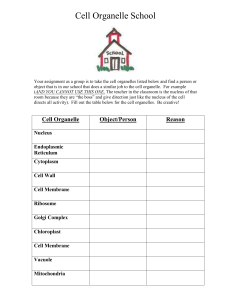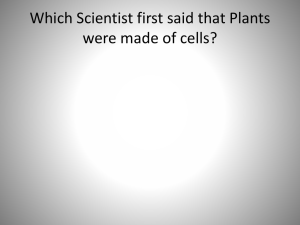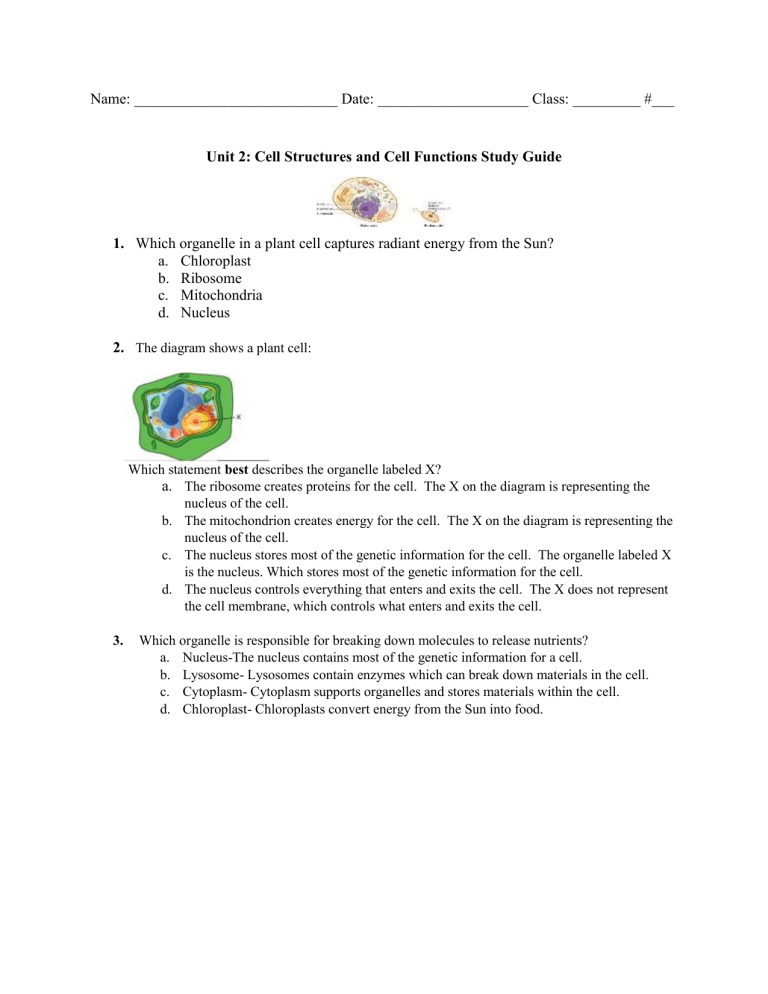
Name: ___________________________ Date: ____________________ Class: _________ #___ Unit 2: Cell Structures and Cell Functions Study Guide 1. Which organelle in a plant cell captures radiant energy from the Sun? a. Chloroplast b. Ribosome c. Mitochondria d. Nucleus 2. The diagram shows a plant cell: Which statement best describes the organelle labeled X? a. The ribosome creates proteins for the cell. The X on the diagram is representing the nucleus of the cell. b. The mitochondrion creates energy for the cell. The X on the diagram is representing the nucleus of the cell. c. The nucleus stores most of the genetic information for the cell. The organelle labeled X is the nucleus. Which stores most of the genetic information for the cell. d. The nucleus controls everything that enters and exits the cell. The X does not represent the cell membrane, which controls what enters and exits the cell. 3. Which organelle is responsible for breaking down molecules to release nutrients? a. Nucleus-The nucleus contains most of the genetic information for a cell. b. Lysosome- Lysosomes contain enzymes which can break down materials in the cell. c. Cytoplasm- Cytoplasm supports organelles and stores materials within the cell. d. Chloroplast- Chloroplasts convert energy from the Sun into food. 4. The table below shows the characteristics of a plant leaf cell and an animal skin cell. CHARACTERISTICS OF PLANT LEAF CELL AND ANIMAL SKIN CELL Which characteristic is missing on the table? a. have a cell life of five to ten days b. perform photosynthesis to make food c. get rid of waste to maintain homeostasis d. use chloroplasts to convert sunlight into energy 5. 6. Which of the following best describes why a cell would not be able to reproduce if its nucleus were damaged? a. The nucleus is responsible for creating the energy used to perform cell division. b. The nucleus is responsible for housing the genetic information needed for cell division. c. The nucleus is responsible for letting the materials in that are needed for cell division. d. The nucleus is responsible for creating the sugars needed to perform cell division. Mercedes created a table to show the functions of different cell structures. What error did Mercedes make when creating her table? a. Mercedes switched the functions of the cytoplasm and ell membrane. The cytoplasm and cell membrane are both correctly described in the table. b. Mercedes switched the functions of the mitochondria and the chloroplasts. Mitochondria provides a cell with most of its energy. A chloroplast uses energy from the Sun to make sugars. c. Mercedes switched the functions of the nucleus and the cell membrane. The nucleus and the cell membrane are both correctly described in the table. d. Mercedes switched the functions of the chloroplast and the nucleus. The nucleus is correctly described in the table. 7. Cells produce the energy they need to survive through the process of: a. Cellular respiration b. Cellular specialization c. Cellular differentiation d. Cellular transport 8. Which organelle controls the activities for the cell? a. Nucleus b. Cytoplasm c. Cell membrane d. Mitochondria 9. The model shows a simple animal cell: Which statement correctly describes how an organelle contributes to the ability of the cell to perform life functions? a. The cytoplasm stores he genetic instructions for the cell. b. The mitochondrion responds to chemical messages in the cell. c. The lysosomes digest food and break down cell parts when they die. d. The cell membrane prevents all harmful substances from entering the cell. 10. Cells contain a certain structure that acts as a gatekeeper in order to maintain homeostasis. This gatekeeper controls what is able to enter and exit the cell. Plant cells oxygen as a waste product. What cell structure allows this oxygen to pass into the environment? a. Chloroplast- This is the result of incorrectly thinking chloroplasts regulate what enters and exits the cell. Chloroplasts are responsible for converting light energy, while the cell membrane is responsible for regulating what enters and exits the cell. b. Vacuole- This is the result of incorrectly thinking vacuoles regulate what enters and exits the cell. Vacuoles are responsible for storing water and other essential nutrients, while the cell membrane is responsible for regulating what enters and exits the cell. c. Endoplasmic Reticulum- This is the result of incorrectly thinking the endoplasmic reticulum regulates what enters and exits the cell. The endoplasmic reticulum is responsible for packaging proteins, while the cell membrane is responsible for regulating what enters and exits the cell. d. Cell membrane- This is correct. The cell membrane regulates material that enters and leaves the cell, including oxygen. 11. Which type of energy transformation is controlled by chloroplasts? a. Chemical to mechanical b. Mechanical to electrical c. Light to chemical d. Heat to electrical 12. This diagram below represents a cell from a leaf of a rose bush. Which structure is responsible for converting light energy into chemical energy? a. b. c. d. 13. 1-This is the result of incorrectly identifying a cell nucleus instead of a chloroplast. 2- This is the result of incorrectly identifying a cell membrane instead of a chloroplast. 3- This is the result of incorrectly identifying a cell wall instead of a chloroplast. 4- This is correct. The arrow pointing to a chloroplast, which is responsible for converting light energy into chemical energy. The diagram shows a eukaryotic cell. Which of these functions is NOT performed by the organelles labeled X as they interact with other structures within the cell? a. The organelles destroy harmful materials that have entered the cytoplasm. This is a function that is performed by lysosomes. b. The organelles digest food that passes into the cell through the cell membrane. This is a function that is performed by lysosomes. c. The organelles break down other organelles such as mitochondria when they are worn out. This is a function that is performed by lysosomes. d. The organelles carry genetic material from inside the nucleus to the chloroplasts for reproduction. The organelles labeled X in the diagram represent lysosomes. Lysosomes contain proteins and enzymes that help the organelles to destroy harmful materials, digest food, and break down other organelles, but do not carry genetic material. 14. Which organelle may often be referred to as the “gatekeeper” because it control what goes in and out of the cell? a. The cytoplasm b. The nucleus c. The cell membrane d. The mitochondrion 15. What is the role of chlorophyll in plant cells? a. It aides in pollination b. It aids in cell division c. It gives off oxygen during respiration d. It absorbs light energy during photosynthesis 16. What is directly related to the function of a cell? a. Color b. Life span c. Movement d. Structure 17. What structure is present in plant cells but NOT animal cells? a. Cell membrane b. Mitochondria c. Nucleus d. Chloroplast 18. The models below show an animal cell and a plant cell. What would NOT be a purpose of using these models together? a. To show he different types of molecules that make each type of cell b. To illustrate that plant cells have a rigid cell wall, while animal cells do not c. To illustrate the differences in shape between plant and animal cells d. To show that plant cells have chloroplasts, while animal cells do not 19. Why do all plant cells contain chloroplasts? a. Chloroplasts are necessary for cellular respiration. b. Chloroplasts are necessary for photosynthesis. c. Chloroplasts are necessary for reproduction. d. Chloroplasts are necessary for growth. 20. The diagram shows a plant cell. Which table correctly identifies the structure and function for each of the letters in the diagram? Letter W represents the membrane that controls what can enter and exit the cell. Letter X represents a chloroplast that converts energy from the Sun into food for the cell. Letter Y represents the nucleus that contains the genetic information and controls the function of the cell. Letter Z represents a mitochondrion that creates energy for the cell. This response has the correct structure for W only.

